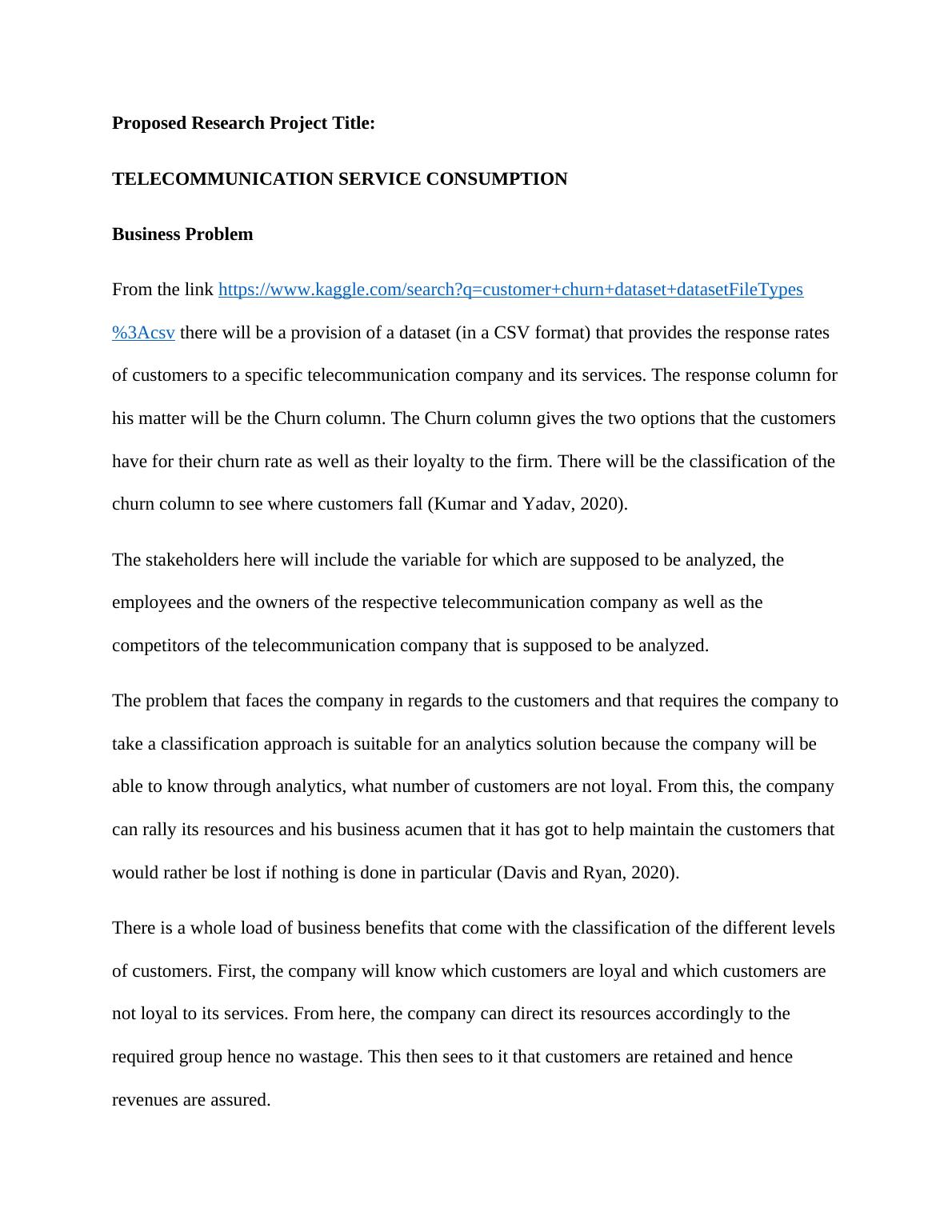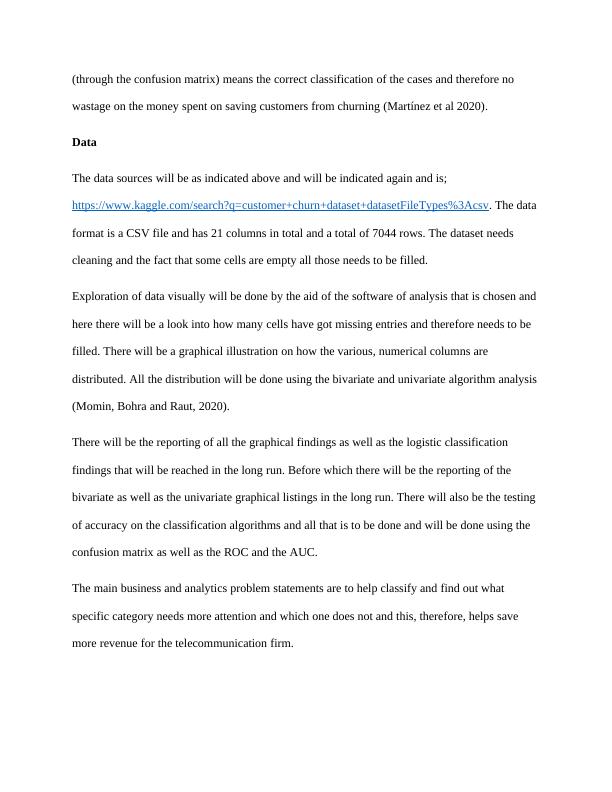Telecommunication Service Consumption in PDF
Added on 2022-08-15
6 Pages1567 Words13 Views
Proposed Research Project Title:
TELECOMMUNICATION SERVICE CONSUMPTION
Business Problem
From the link https://www.kaggle.com/search?q=customer+churn+dataset+datasetFileTypes
%3Acsv there will be a provision of a dataset (in a CSV format) that provides the response rates
of customers to a specific telecommunication company and its services. The response column for
his matter will be the Churn column. The Churn column gives the two options that the customers
have for their churn rate as well as their loyalty to the firm. There will be the classification of the
churn column to see where customers fall (Kumar and Yadav, 2020).
The stakeholders here will include the variable for which are supposed to be analyzed, the
employees and the owners of the respective telecommunication company as well as the
competitors of the telecommunication company that is supposed to be analyzed.
The problem that faces the company in regards to the customers and that requires the company to
take a classification approach is suitable for an analytics solution because the company will be
able to know through analytics, what number of customers are not loyal. From this, the company
can rally its resources and his business acumen that it has got to help maintain the customers that
would rather be lost if nothing is done in particular (Davis and Ryan, 2020).
There is a whole load of business benefits that come with the classification of the different levels
of customers. First, the company will know which customers are loyal and which customers are
not loyal to its services. From here, the company can direct its resources accordingly to the
required group hence no wastage. This then sees to it that customers are retained and hence
revenues are assured.
TELECOMMUNICATION SERVICE CONSUMPTION
Business Problem
From the link https://www.kaggle.com/search?q=customer+churn+dataset+datasetFileTypes
%3Acsv there will be a provision of a dataset (in a CSV format) that provides the response rates
of customers to a specific telecommunication company and its services. The response column for
his matter will be the Churn column. The Churn column gives the two options that the customers
have for their churn rate as well as their loyalty to the firm. There will be the classification of the
churn column to see where customers fall (Kumar and Yadav, 2020).
The stakeholders here will include the variable for which are supposed to be analyzed, the
employees and the owners of the respective telecommunication company as well as the
competitors of the telecommunication company that is supposed to be analyzed.
The problem that faces the company in regards to the customers and that requires the company to
take a classification approach is suitable for an analytics solution because the company will be
able to know through analytics, what number of customers are not loyal. From this, the company
can rally its resources and his business acumen that it has got to help maintain the customers that
would rather be lost if nothing is done in particular (Davis and Ryan, 2020).
There is a whole load of business benefits that come with the classification of the different levels
of customers. First, the company will know which customers are loyal and which customers are
not loyal to its services. From here, the company can direct its resources accordingly to the
required group hence no wastage. This then sees to it that customers are retained and hence
revenues are assured.

Analytics Problem
As had been pointed above, the business aim is the retention of the revenues that would rather be
lost if efforts are not taken to retain the customers that would rather churn. Analytically, with all
the relevant independent variables, there will be the classification of the response or target
variable to help find out what numbers of customers should be focused on the more. There will
be performance evaluation and additional tweaks on the classification algorithms to help aid the
correctness of the two customers’ categories (Meghyasi and Rad, 2020).
The ABT attributes are the variables that would rather be used in the development of the
classification models and in a listing they are; customerID, gender, SeniorCitizen, Partner,
Dependents tenure, phone service, multiple lines, InternetService, online security, online
backup, DeviceProtection, TechSupport, StreamingTV, StreamingMovies, Contract,
PaperlessBilling, PaymentMethod, MonthlyCharges and TotalCharges. They are not all to be
used as others will be cleaned out in the algorithms to build-up processes.
The assumption that is employed in the algorithms that will be built up from the business
problem will be that all the independent variables will help give the most accurate classification
of the cases in consideration (Rai, Khandelwal and Boghey, 2020).
The metrics of success by the end of the deployment of the analytical algorithm used for the
classification of the churn column will be to find out the increased and retained revenue levels
when the customers that are planning to churn are retained. The next one will be to try and find
out if by any chance the calcification algorithms have a higher percentage level of accuracy
when it comes to the classification of the same response column. A higher level of accuracy
As had been pointed above, the business aim is the retention of the revenues that would rather be
lost if efforts are not taken to retain the customers that would rather churn. Analytically, with all
the relevant independent variables, there will be the classification of the response or target
variable to help find out what numbers of customers should be focused on the more. There will
be performance evaluation and additional tweaks on the classification algorithms to help aid the
correctness of the two customers’ categories (Meghyasi and Rad, 2020).
The ABT attributes are the variables that would rather be used in the development of the
classification models and in a listing they are; customerID, gender, SeniorCitizen, Partner,
Dependents tenure, phone service, multiple lines, InternetService, online security, online
backup, DeviceProtection, TechSupport, StreamingTV, StreamingMovies, Contract,
PaperlessBilling, PaymentMethod, MonthlyCharges and TotalCharges. They are not all to be
used as others will be cleaned out in the algorithms to build-up processes.
The assumption that is employed in the algorithms that will be built up from the business
problem will be that all the independent variables will help give the most accurate classification
of the cases in consideration (Rai, Khandelwal and Boghey, 2020).
The metrics of success by the end of the deployment of the analytical algorithm used for the
classification of the churn column will be to find out the increased and retained revenue levels
when the customers that are planning to churn are retained. The next one will be to try and find
out if by any chance the calcification algorithms have a higher percentage level of accuracy
when it comes to the classification of the same response column. A higher level of accuracy

(through the confusion matrix) means the correct classification of the cases and therefore no
wastage on the money spent on saving customers from churning (Martínez et al 2020).
Data
The data sources will be as indicated above and will be indicated again and is;
https://www.kaggle.com/search?q=customer+churn+dataset+datasetFileTypes%3Acsv. The data
format is a CSV file and has 21 columns in total and a total of 7044 rows. The dataset needs
cleaning and the fact that some cells are empty all those needs to be filled.
Exploration of data visually will be done by the aid of the software of analysis that is chosen and
here there will be a look into how many cells have got missing entries and therefore needs to be
filled. There will be a graphical illustration on how the various, numerical columns are
distributed. All the distribution will be done using the bivariate and univariate algorithm analysis
(Momin, Bohra and Raut, 2020).
There will be the reporting of all the graphical findings as well as the logistic classification
findings that will be reached in the long run. Before which there will be the reporting of the
bivariate as well as the univariate graphical listings in the long run. There will also be the testing
of accuracy on the classification algorithms and all that is to be done and will be done using the
confusion matrix as well as the ROC and the AUC.
The main business and analytics problem statements are to help classify and find out what
specific category needs more attention and which one does not and this, therefore, helps save
more revenue for the telecommunication firm.
wastage on the money spent on saving customers from churning (Martínez et al 2020).
Data
The data sources will be as indicated above and will be indicated again and is;
https://www.kaggle.com/search?q=customer+churn+dataset+datasetFileTypes%3Acsv. The data
format is a CSV file and has 21 columns in total and a total of 7044 rows. The dataset needs
cleaning and the fact that some cells are empty all those needs to be filled.
Exploration of data visually will be done by the aid of the software of analysis that is chosen and
here there will be a look into how many cells have got missing entries and therefore needs to be
filled. There will be a graphical illustration on how the various, numerical columns are
distributed. All the distribution will be done using the bivariate and univariate algorithm analysis
(Momin, Bohra and Raut, 2020).
There will be the reporting of all the graphical findings as well as the logistic classification
findings that will be reached in the long run. Before which there will be the reporting of the
bivariate as well as the univariate graphical listings in the long run. There will also be the testing
of accuracy on the classification algorithms and all that is to be done and will be done using the
confusion matrix as well as the ROC and the AUC.
The main business and analytics problem statements are to help classify and find out what
specific category needs more attention and which one does not and this, therefore, helps save
more revenue for the telecommunication firm.

End of preview
Want to access all the pages? Upload your documents or become a member.
Related Documents
Machine Learning on Health Tweets Case Study 2022lg...
|25
|4450
|14
Big Data and Machine Learninglg...
|6
|2777
|24
Data Analysis and Digital Operations for Customer Loyalty in a Telecommunication Companylg...
|18
|2711
|438
Financial, Sustainable and Corporate Social Responsibility Analysis of Telstra Corporation Ltd.lg...
|21
|4574
|262
Human Resource Development (HRD) : EFC Assignmentlg...
|7
|1819
|94
